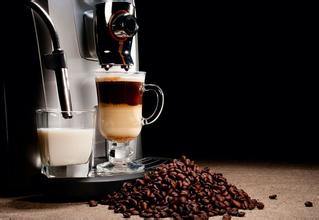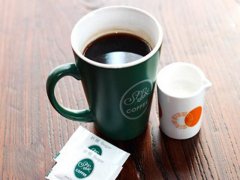What is Arabica coffee?

In many places where coffee is sold, it is not difficult to find words like "100% Arabica". Even canned coffee has a style called Arabica coffee, which makes one wonder: what is "Arabica coffee"?
In fact, Arabica is the name of the coffee tree variety (species).
"Arabica" and "Robusta" are two different varieties of coffee, which currently account for the vast majority of coffee beans in the world. There are three main differences between Arabica coffee and Robusta coffee: 1. Differences in planting conditions. two。 The flavor and characteristics are different. 3. The difference between market price and use. Planting condition difference
The planting conditions of "Arabica" coffee are more stringent, requiring higher elevations (more than 2000 meters above sea level), fertile soil fertility, adequate moisture, proper sunshine conditions and shade. "Arabica" coffee species are less resistant to diseases and insect pests and are vulnerable to damage. In addition, the annual output of coffee trees per unit area is also relatively low. At present, Arabica coffee accounts for 75% of the world's coffee production, and of these Arabica coffee production, only 10% of Arabica coffee quality can be classified as "boutique coffee (Specialty coffee)." "Robusta" coffee, commonly known as "sturdy beans," can be grown at low elevations (200 to 800 meters above sea level). It has strong resistance to diseases and insect pests and is not vulnerable to agricultural diseases. the annual output of coffee trees per unit area is relatively high, and it is harvested in large quantities by machine. generally speaking, the cost of production is much lower than that of Arabica coffee.
Different flavors and characteristics
Arabica coffee has a varied and broad potential flavor. Arabica coffee produced in different regions, different elevations and different climates usually has its own characteristics and can show a completely different flavor. "Arabica" coffee smells like grass when it is not roasted. After proper roasting, it shows "fruity" (medium light roasted) and "caramel sweet" (deep roasted). Generally speaking, it has a better aroma and flavor than Robota beans. "Robusta" coffee usually has an ordinary, rigid, and pungent flavor, and because the vast majority of Robusta coffee in the world is planted in low altitude areas (India has planted a small number of high-altitude, high-quality, washed Robusta coffee beans, its price is higher than most Arabica coffee beans) different regions and different climates do not have much difference in flavor, and lack personality. When unbaked, it smells like raw peanuts, and the taste of cheap robusta coffee beans is usually between "wheat tea" (medium\ baked) and "rubber tire" (deep baked). It is difficult to show a fine flavor.
Difference between market price and use
High-quality Arabica coffee requires a complicated process of hand picking, selection and fine processing, so the most expensive and best coffee beans in the world are Arabica coffee. "Robusta" caffeine is low-cost and is usually used to produce instant coffee and canned coffee. A small number of better quality "Robusta" coffee are also used in blending (mixed with Arabica coffee) espresso beans.
There is an important difference in other differences: caffeine content, "Robusta" coffee contains about twice as much caffeine as "Arabica" coffee, which is why drinking some canned coffee is prone to palpitations and insomnia.
After seeing so many differences between Arabica Coffee and Robusta Coffee, we must finally emphasize:
"Arabica coffee" is not the same as "good coffee", "Robusta" is not absolutely cheap coffee!
Arabica coffee accounts for 75% of the world's coffee output, and the quality of Arabica coffee varies greatly, from good to bad. In recent years, a few countries (such as India) have devoted themselves to improving the quality of robusta coffee. They have planted robusta in high altitude areas, given the most careful care, and carefully washed the coffee. As a result, they have got very high-quality robusta coffee beans! Top Robusta beans are not cheap either, getting rid of the old impression that Robusta are cheap beans! Therefore, the quality of coffee beans can no longer be judged by the crude and outdated ancient criterion of "Arabica beans".
Important Notice :
前街咖啡 FrontStreet Coffee has moved to new addredd:
FrontStreet Coffee Address: 315,Donghua East Road,GuangZhou
Tel:020 38364473
- Prev

Introduction to Librika Coffee beans
Liberica coffee beans: large shrubs or small trees, 6-15 m tall; dark brown bark; branches spreading, hard and straight. Leaves opposite, leathery, elliptic or Obovate-elliptic, 15-30 cm long, tip mucronate, base broadly cuneate, margin entire, rarely microwave, often with small pores in lower vein axils; petiole 8-20 mm long; stipules broadly triangular, 3-4 mm long, tip obtuse, rarely convex
- Next

Introduction of honey treatment method for raw bean of high-quality coffee
The so-called honey treatment (Miel Process in Spanish) is said to refer to the process of making raw beans by sun-drying with mucous membranes. After the outer pulp of the coffee bean is removed, there will be a layer of sticky jelly. The traditional method of washing is to wash it off with clean water, but because of the limitation of water resources in some high-altitude areas, there is this way of direct drying. Honey treatment process
Related
- Guji coffee producing area of Guji, Ethiopia: Humbela, Shakiso, Wulaga
- What is the most expensive variety of Qiloso in BOP multi-variety group?
- How to store the coffee beans bought home?
- Why are Yemeni coffee beans so rare now?
- Ethiopian Sidamo all Red Fruit Sun Sun Santa Vini Coffee beans
- SOE is mostly sour? What does it mean? Is it a single bean? what's the difference between it and Italian blending?
- Is Italian coffee beans suitable for making hand-brewed coffee?
- How to choose coffee beans when making cold coffee? What kind of coffee beans are suitable for making cold coffee?
- Just entered the pit to make coffee, what kind of coffee beans should be chosen?
- Can only Japan buy real Blue Mountain Coffee? What are authentic Jamaican Blue Mountain coffee beans?

